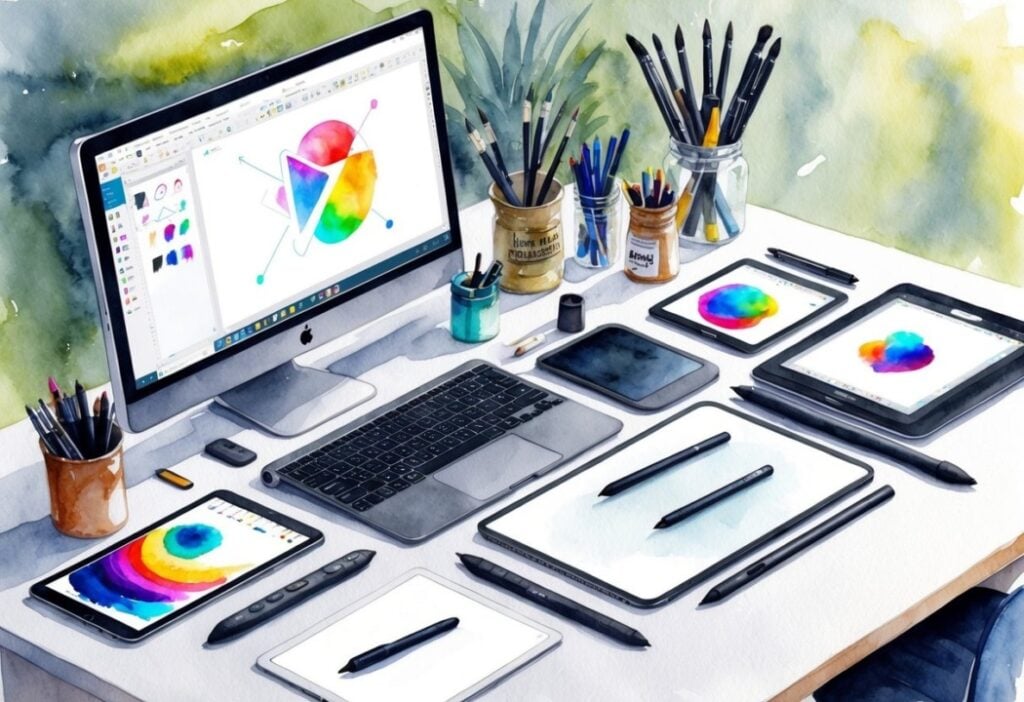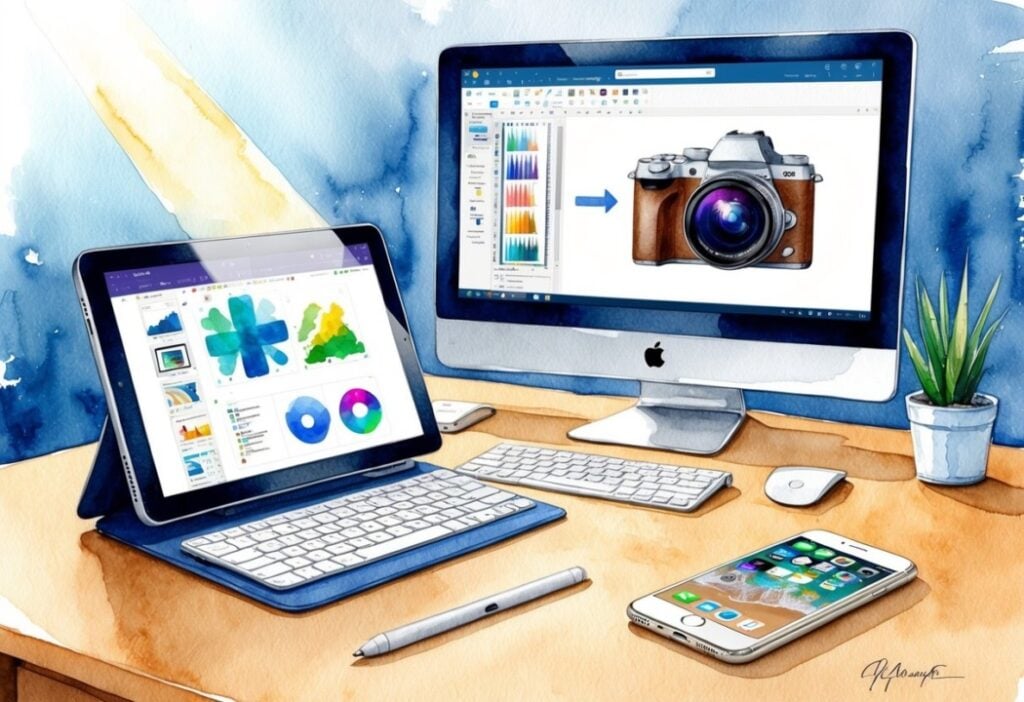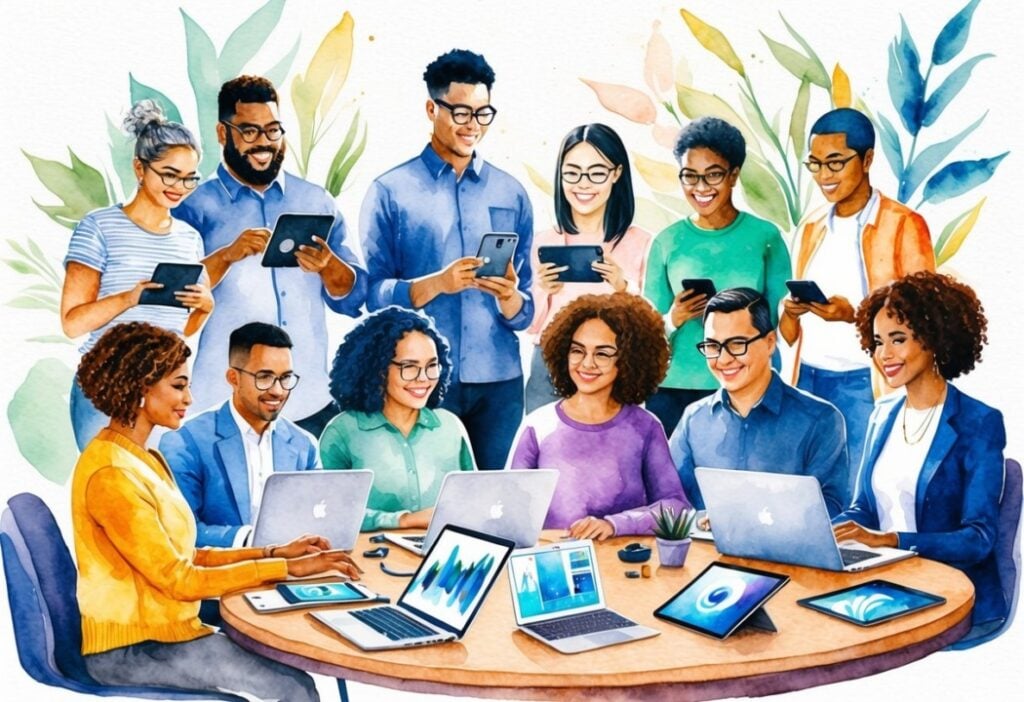In today’s world, technology plays an exciting role in visual creativity. AI art software and digital tools are transforming the landscape, making artistic expression accessible to everyone. With these innovations, the gap between amateur and professional artists is shrinking, allowing more people to unlock their creative potential.
When I look at the rapid advancements in technology, I see how they’re leveling the playing field. From smart design platforms to intuitive photo editing apps, tools that were once exclusive to experts are now open to all. This democratization invites anyone with a spark of creativity to dive into the world of art and design.
Innovations don’t just enhance our artistic capabilities; they also spark collaboration and dialogue. Technologies like AI and digital editing platforms inspire both traditional and modern artists to push boundaries.
Key Takeaways
- Technology opens art to everyone.
- Anyone can explore creative tools.
- New tech encourages collaboration.
The Evolution of Visual Creativity Tools

Visual creativity has transformed significantly, driven by technological advances. Today, both amateurs and professionals have access to innovative tools that allow them to express ideas in ways not previously possible. One such tool that stands out in this evolution is https://www.photoleapapp.com/, an app that offers users powerful editing capabilities to bring their visions to life with ease. Whether for casual editing or professional-grade design, platforms like Photoleap have made it easier than ever to push the boundaries of visual creativity.
Historical Context
Initially, visual creativity relied heavily on physical tools like brushes, canvases, and darkrooms. The introduction of photography in the 19th century was a major breakthrough. It changed how people captured and shared visual stories. Darkroom techniques were complex, requiring skill and experience.
As time went on, tools like film cameras brought about more accessible forms of creativity. These allowed amateurs to engage with art without needing professional training. This democratization laid the groundwork for future advancements in digital tools.
Modern Advances
Over recent decades, we’ve seen new digital tools reshape visual creativity. Software like Adobe Photoshop and apps like the Photoleap App provide sophisticated features for editing and creating images with ease. Such tools offer a range of options, from basic edits to complex manipulations.
Moreover, the development of AI-powered tools is expanding possibilities. These intelligent systems can enhance creativity by suggesting new ideas and automating tasks. Through mobile devices, access to high-caliber creative tools has opened up, allowing anyone to experiment with visual art wherever they are.
This evolution signifies how technology continues to bridge gaps in creativity, making advanced tools available to everyone, regardless of their skill level.
Bridging the Gap

Technology has transformed visual creativity by making tools once limited to professionals available to anyone with an interest. This has allowed hobbyists to hone their skills and professionals to expand their creative boundaries.
From Hobbyist to Professional
In my experience, the journey from hobbyist to professional is influenced heavily by technology. Once, only professionals could afford high-quality cameras and editing software, but now these tools are accessible to everyone. Digital platforms like Adobe Photoshop and free alternatives allow anyone to edit and enhance their pictures efficiently. Online tutorials and community forums provide insights and advice that were once restricted to those with personal connections in the industry.
Professional-level equipment, paired with continuous learning opportunities, means that budding photographers and videographers can develop their craft skills at an impressive pace. They can create portfolios and share their work widely, reaching potential clients without needing a studio or gallery space.
Impact of Accessibility
Accessibility is key in bridging this gap as well. I see more people developing their skills because tools and resources are easier to access. With smartphones, anyone can take high-quality photos, experiment with editing apps, and start learning the basics of photography.
Platforms like YouTube and online courses offer lessons straight from experts, teaching essential techniques and business aspects. The availability of affordable tools and resources means that people can establish themselves in creative fields without a large initial investment. The democratization of knowledge and tools promotes diversity in visual creativity, offering opportunities to those who might otherwise be unable to pursue this field.
Key Technologies in Democratization
Technology is making it easier for everyone, from amateurs to professionals, to create visually stunning content. Key advancements in software and hardware play a crucial role in this shift.
Software Solutions
There are various software solutions that help bridge the gap in visual creativity. Tools like the Photoleap App make sophisticated photo editing accessible to beginners without the need for advanced skills. Such apps offer user-friendly interfaces and powerful features.
Cost-effective subscription models allow more individuals to access these high-end tools. Additionally, built-in tutorials guide users step-by-step, making learning less intimidating. Other software like Adobe Spark and Canva provide templates for quick design creation. By lowering the technical barrier, these tools empower creativity in a broader audience.
Hardware Accessibility
Advancements in hardware have made professional-grade equipment more affordable and accessible. High-quality cameras are now available in smartphones, putting powerful photography tools in the hands of many. This accessibility enables people to produce high-quality images and videos on the go.
Affordable laptops with robust processing capabilities make running advanced software possible without needing costly setups. The ease of access to such technology encourages creativity by giving more people the means to experiment and create. By democratizing hardware, individuals can achieve professional results with fewer resources, expanding the creative possibilities significantly.
Challenges and Considerations
Navigating the intersection between amateur and professional design involves ethical concerns and debates on skills versus tools. These challenges merit close examination to properly assess how technology affects creativity.
Ethical Implications
I often think about the ethical aspects of technological tools in creativity. One important issue is intellectual property. When amateur designers use easy-to-access images and sounds, it can sometimes lead to unintentional misuse or copyright infringement. The ease of access to tools makes it essential for creators to understand these rules.
Another point is bias in AI-driven design software. These tools can reflect the biases of their developers, affecting the quality and fairness of the designs produced. It’s crucial for everyone using these tools to remain vigilant and to demand improvements that promote inclusivity and fairness.
Skill Versus Tool Debate
While technology offers powerful design tools, there is an ongoing conversation about the importance of foundational skills. I hear arguments that technology might overshadow traditional skills such as drawing or color theory, which are essential in design education. This can lead to over-reliance on software, potentially stunting creative growth.
However, it’s crucial to balance skills and tools. I believe that while tools can enhance creativity, they should not replace an understanding of fundamental design principles. By combining both elements, designers can maximize the potential of technology without compromising on creative quality.
Future Prospects
Technology continues to transform how I engage with visual creativity. New tools and platforms are making creative processes more accessible and inspiring fresh approaches.
Emerging Trends
In the world of visual creativity, one trend I see is the rise of apps and platforms like the Photoleap App. These tools help bridge the gap between amateurs and professionals by offering features that were once exclusive to experts.
Augmented Reality (AR) is another key player. It allows me to merge digital creations with real-world environments. This technology is changing how I create and display my work, providing new opportunities for interactive art.
Virtual Reality (VR) is also expanding. It offers immersive experiences, letting me explore new dimensions of creativity that go beyond traditional media.
Continued Innovation
Continuous improvements in technology keep opening new doors for visual artists like me. AI-powered tools give me the ability to automate repetitive tasks and enhance my creative processes. This saves time and lets me focus more on the artistic side of my work.
Apps like Photoleap offer features like advanced editing and effects. These allow me to experiment and push boundaries, making my creations stand out.
Collaborative platforms are also evolving. They enable me to connect with others, share ideas, and develop projects in a more interactive way. This fosters a community of learning and innovation, promoting growth for all participants.
Frequently Asked Questions
I’ve seen how technology is transforming the way amateur artists engage with visual creativity. Tools like smartphones, apps, and online platforms are making it easier for emerging talents to create and share their work. Here’s what you need to know about this exciting shift.
How is technology making it easier for amateur artists to create professional-quality work?
Technology offers advanced software and tools that are more affordable and user-friendly. These tools help amateur artists produce high-quality work without needing expensive equipment. Features like automated editing and easy-to-use interfaces simplify the creative process, allowing artists to focus more on their art.
In what ways have smartphones and apps influenced the accessibility of visual creativity?
Smartphones and apps have turned into powerful tools for creation. They offer high-resolution cameras and editing software right at our fingertips. This makes it simple for anyone to capture images, edit them, and share their work directly with an audience, all from a mobile device.
What role do online platforms play in helping new creatives showcase their work?
Online platforms provide a space for artists to display their work, reach a global audience, and gain feedback. These platforms, such as social media or specialized art sites, allow artists to connect with others and grow their following, offering opportunities for exposure that were once hard to achieve.
How have advancements in software and hardware expanded the capabilities of non-professional creators?
The latest software and hardware are designed to support creative endeavors, regardless of the user’s professional status. Features like easy-to-use editing programs and high-performance graphic tablets give non-professionals the tools they need to experiment and refine their skills, bringing their creative visions to life.
What training resources have become more accessible to aspiring artists due to technology?
Numerous online courses, tutorials, and workshops are available for free or at a low cost, accessible from anywhere. Platforms like YouTube, Skillshare, and Coursera provide aspiring artists with the chance to learn new techniques and improve their skills with guidance from experienced professionals.
How does the increase in accessible technology affect the traditional barriers to entry in the visual arts industry?
Accessible technology lowers the barriers by reducing the need for expensive equipment and formal training. It democratizes art creation, allowing more individuals to participate in the visual arts. This results in a richer diversity of styles and voices within the industry, broadening the landscape for visual arts.

Amanda Dudley is a lecturer and writer with a Ph.D. in History from Stanford University. After earning her doctorate in 2001, she decided to pursue a fulfilling career in the educational sector. So far, she has made giant strides by working as an essay writer for EssayUSA, where she delivers high-quality academic papers to students who need them.




![‘Jay Kelly’ Review – Noah Baumbach Makes A Case For The Magic Of Movie Stardom [NYFF 2025] ‘Jay Kelly’ Review – Noah Baumbach Makes A Case For The Magic Of Movie Stardom [NYFF 2025]](https://cdn.geekvibesnation.com/wp-media-folder-geek-vibes-nation/wp-content/uploads/2025/11/Jay-Kelly-JKELLY_20240523_15320_C2_R-300x180.jpg)

